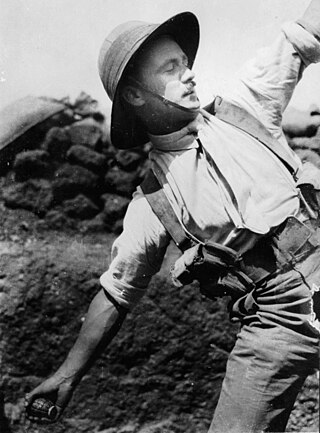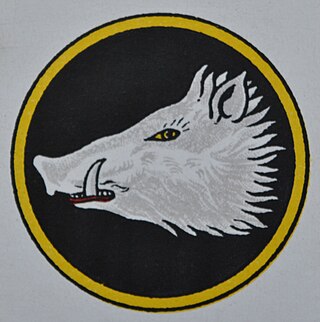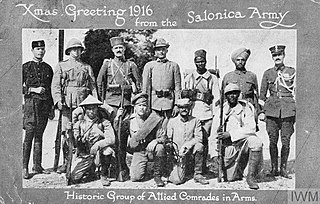
The Twelfth Army was a British Army formation during the Second World War. The Twelfth Army denotation was actually used twice; firstly, in 1943, for a fictional formation and secondly, in 1945, in Burma.

The British Salonika Army was a field army of the British Army during World War I. After the armistice in November 1918, it was disbanded, but component units became the newly formed Army of the Black Sea, and General Milne remained in command.

The Fourth Army was a field army that formed part of the British Expeditionary Force during the First World War. The Fourth Army was formed on 5 February 1916 under the command of General Sir Henry Rawlinson to carry out the main British contribution to the Battle of the Somme.

Lieutenant Colonel Daniel Burges, VC, DSO was an English recipient of the Victoria Cross, the highest and most prestigious award for gallantry in the face of the enemy that can be awarded to British and Commonwealth forces.
The Isle of Man Volunteers was a nominal battalion of Britain's Volunteer Force formed during the 1860s and disbanded in 1920. Its service companies saw active service in the Second Boer War and World War I. During its existence, the battalion had the distinction of being the only representative of the Isle of Man in the British Army, and the last Volunteer Force unit.

Field Marshal George Francis Milne, 1st Baron Milne, was a senior British Army officer who served as Chief of the Imperial General Staff (CIGS) from 1926 to 1933. He served in the Second Boer War and during the First World War he served briefly on the Western Front but spent most of the war commanding the British forces on the Macedonian front. As CIGS he generally promoted the mechanization of British land forces although limited practical progress was made during his term in office.

The Third Battle of Doiran was fought from 18–19 September 1918, with the British and the Greeks assaulting the positions of the Bulgarian First Army near Dojran Lake. The battle was part of World War I and took place in the Balkan Theatre. The battle ended with the Bulgarians repulsing all attacks.
The 28th Division was an infantry division of the British Army raised for service in World War I.
228th Brigade was a formation of the British Army in both the First and Second World Wars.

The Macedonian front, also known as the Salonica front, was a military theatre of World War I formed as a result of an attempt by the Allied Powers to aid Serbia, in the autumn of 1915, against the combined attack of Germany, Austria-Hungary and Bulgaria. The expedition came too late and in insufficient force to prevent the fall of Serbia, and was complicated by the internal political crisis in Greece. Eventually, a stable front was established, running from the Albanian Adriatic coast to the Struma River, pitting a multinational Allied force against the Bulgarian Army, which was at various times bolstered with smaller units from the other Central Powers. The Macedonian front remained quite stable, despite local actions, until the great Allied offensive in September 1918, which resulted in the capitulation of Bulgaria and the liberation of Serbia.

XIII Corps was a corps-sized formation of the British Army that fought on the Western Front during the First World War and was reformed for service during the Second World War, serving in the Mediterranean and Middle East throughout its service.
The Surrey Yeomanry was a unit of the British Army first formed as volunteer cavalry in 1794. It was reformed in 1901 and saw varied srvice in World War I. Postwar it was converted to artillery and during World War II one of its regiments distinguished itself defending the 'Canal Line' during the retreat to Dunkirk, later serving at Alamein, in Sicily and Italy. Its other regiment served in East Africa, the Siege of Tobruk, and in Iraq and Persia. The regiment's lineage is maintained today by 2 Field Troop, 579 Field Squadron (EOD), part of 101 (London) Engineer Regiment (Volunteers).

XII Corps was an army corps of the British Army that fought in the First and Second World Wars. In the First World War, it formed part of the British Salonika Force on the Macedonian front. In the Second World War, it formed part of the British Second Army during Operation Overlord and the subsequent North-West Europe Campaign of 1944-45.
Lieutenant-General Sir Henry Fuller Maitland Wilson was a British soldier who served in the Second Anglo-Afghan War, the Second Boer War and the First World War, during which he commanded a division on the Western Front and an army corps at Salonika.

The Vardar offensive was a World War I military operation, fought between 15 and 29 September 1918. The operation took place during the final stage of the Balkans Campaign. On September 15, a combined force of Serbian, French and Greek troops attacked the Bulgarian-held trenches in Dobro Pole, at the time part of Serbia. The assault and the preceding artillery preparation had devastating effects on Bulgarian morale, eventually leading to mass desertions.

XIV Corps was a British infantry corps during the First World War. During the Second World War the identity was recreated for deceptive purposes.
Brigadier-General Francis Stewart Montague-Bates,, (1876–1954) was a British Army officer in the early part of the 20th century, seeing active service in the Second Boer War, the First World War, the Occupation of Constantinople, the Anglo-Irish War, and the Second World War.

The Allied Army of the Orient (AAO) was the name of the unified command over the multi-national allied armed forces on the Salonika front during the First World War.

The 1st Hampshire Engineer Volunteer Corps was first formed in 1862 and then reformed in 1891 with special responsibility for the port defences of the South Coast of England. It carried out this role during World War I, as well as forming field units that served on the Western Front and at Salonika. Before the outbreak of World War II it formed an air defence regiment that saw service during The Blitz and field companies that fought in the Western Desert and Italy, The unit continued in the postwar Territorial Army before finally disbanding in 1967.

134th Siege Battery was a heavy howitzer unit of Britain's Royal Garrison Artillery (RGA) raised during World War I. It saw active service at Salonika and in Palestine.













